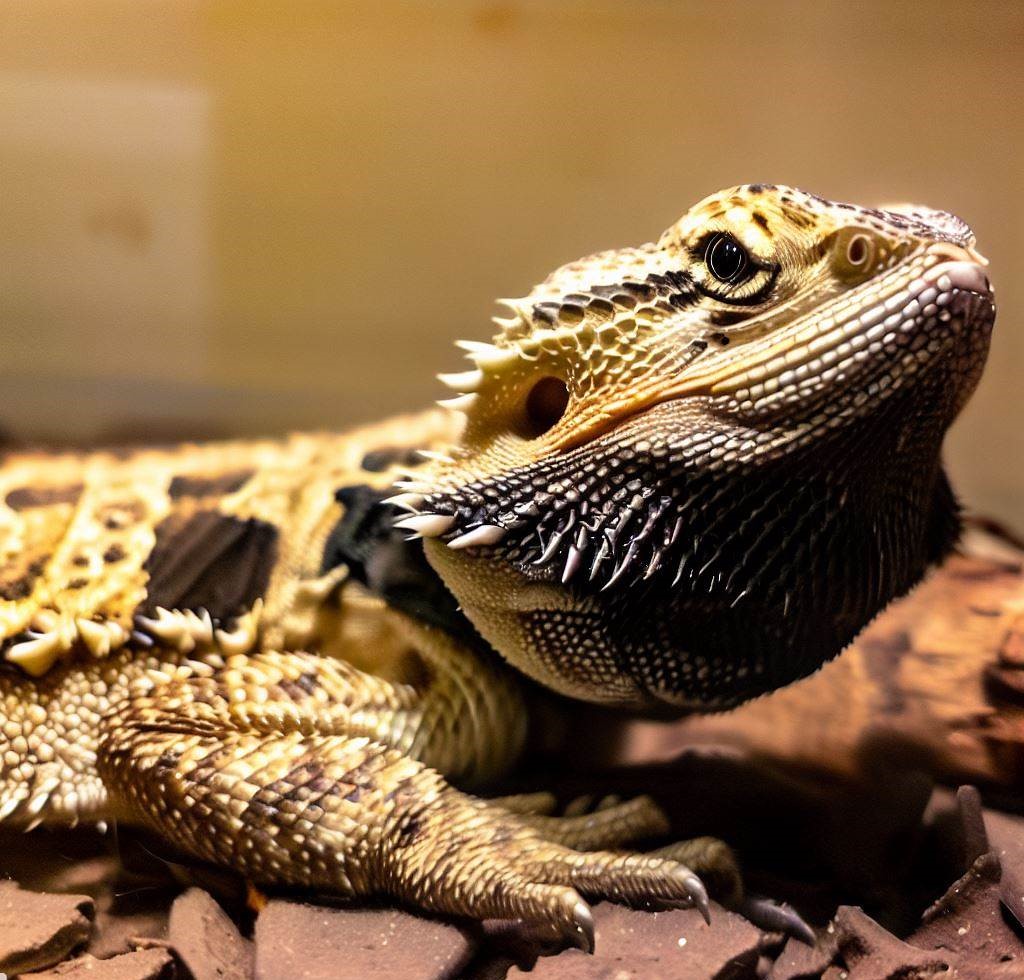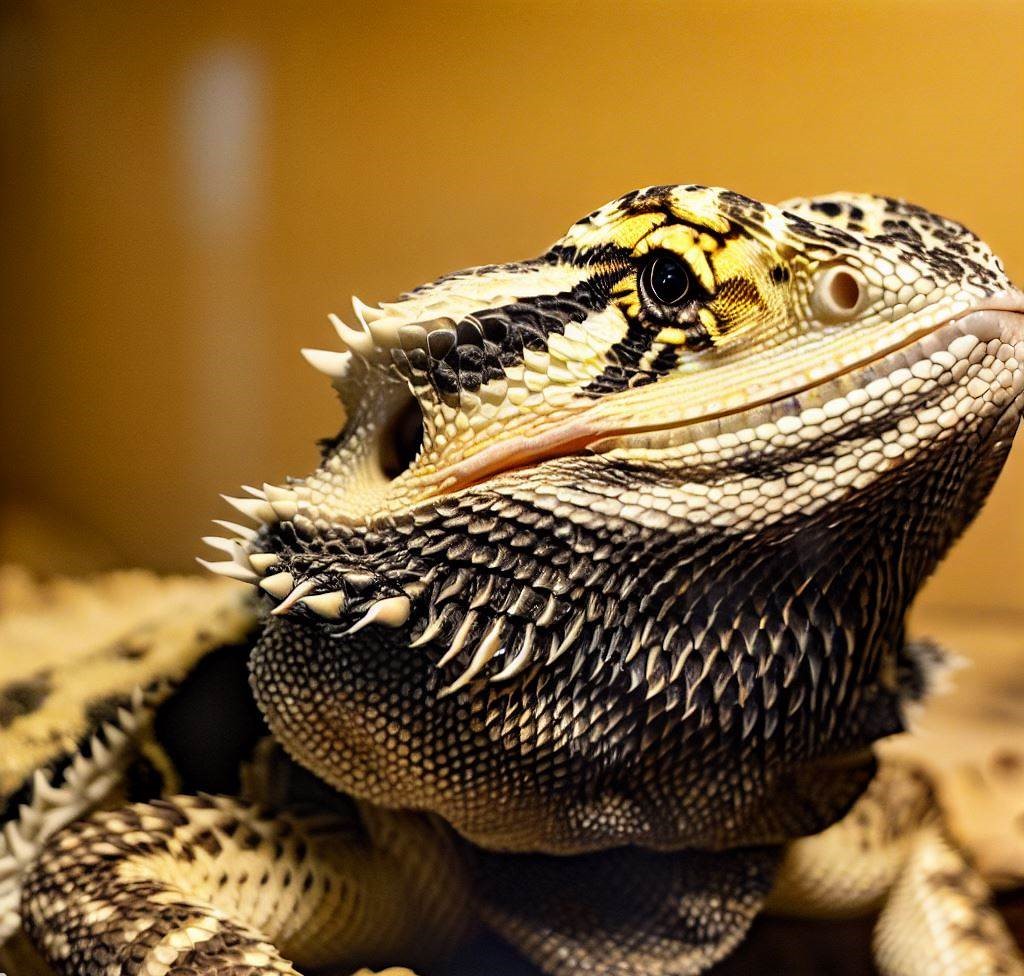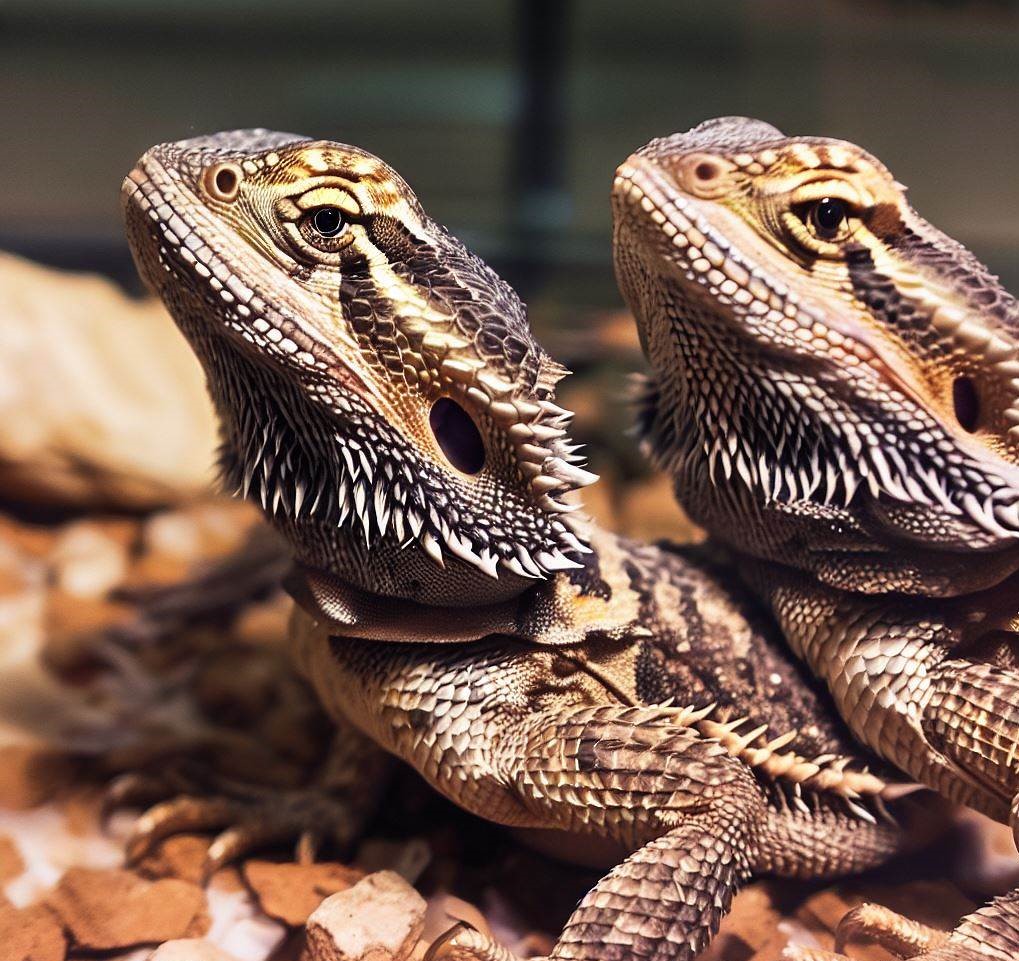Even the tiniest details can make a big difference when it comes to your beloved bearded dragon. And let’s face it, seeing those black spots on your scaly friend can make you raise an eyebrow or two.
Why do those black spots appear? What are the causes of black spots on bearded dragons, you ask? Well, that’s exactly what we’re about to uncover. From stress marks to pesky fungal infections, these spots can indicate various health issues.
But don’t worry. We’re here to help you identify and tackle these potential problems head-on. So get ready to dive into the fascinating world of bearded dragon color changes as we explore not one, not ten, but a whopping 15 potential reasons behind those mysterious black spots on your bearded dragon.
Let’s get started!
Table of Contents
What Causes Black Spots on Bearded Dragons?

Black spots on bearded dragons can come as a surprise for you, causing concern. But, they could be a sign of some conditions, some harmless, others requiring attention. Here, we explore each of these 15 possibilities in detail.
Natural Coloration or Freckle
Black spots on bearded dragons can be their natural coloration or markings. As humans have moles or freckles, bearded dragons can show dark spots on their skin as part of their genetic makeup.
If the black spots were present when you got your dragon, and they’re not increasing in number or size, they’re likely nothing to worry about.
Shedding
Shedding is another common cause of black spots on bearded dragons. These reptiles shed their skin in pieces, unlike snakes, which do so all at once. This process often results in patches of old skin looking darker before shedding.
Don’t worry. The spots will fade away once the shedding process is complete.
Injury or Abrasion
Physical injuries or abrasions can lead to the appearance of black spots. These spots are like scabs that form as part of the healing process. If your bearded dragon has recently had an accident or scrape, the dark spots are likely temporary and will heal with time.
Burn Mark
Bearded dragons are susceptible to burns, which can result in black spots. This usually happens if the basking light or under-tank heater is too hot or they come in direct contact with these heat sources.
If you suspect a burn, it’s essential to adjust the heat settings.
Poor Hygiene
An unclean enclosure can breed bacteria and mold, which can cause skin infections, visible as black spots. Regular cleaning of your bearded dragon’s home is crucial to prevent this issue.
Always remove uneaten food and waste once a month to keep their environment hygienic.
Stress
Stress can have unexpected effects on our bearded dragon pals, even leading to the appearance of black spots. Whether it’s a new habitat, tank mate, or too much handling, environmental changes can stress out these little reptiles.
The key is to identify and address the source of stress, which in turn can help those pesky black spots fade away. Let’s ensure our bearded dragons live a stress-free and spot-free life!
Black Fungal Infection
One potential concern that can lead to black spots is a bearded dragon black fungus infection. It’s often a result of a damp and unclean enclosure.
If your dragon develops a black, velvety coating or has spots growing or spreading, it’s essential to seek veterinary attention.
Bacterial Infections
Bacterial infections can manifest as black spots on your dragon’s skin. These infections can arise due to poor hygiene, cuts, or weakened immune systems. Bacterial infections can quickly worsen, so it’s essential to get a diagnosis and treatment from a vet.
Parasites and Infestations
Parasites, such as mites, can also cause dark spots. The spots might be parasites or a skin reaction to their presence or bites. Regular health checkups can help identify and treat such infestations early.
Nutritional Deficiencies
Nutritional deficiencies can lead to skin darkening in bearded dragons, including the appearance of black spots. A well-balanced diet high in minerals and vitamins is crucial to prevent such issues.
Consult with a vet or a reptile nutrition expert to ensure your dragon’s diet meets its needs.
Temperature Changes
Just like us, sudden temperature changes can cause stress in bearded dragons. This stress can lead to the appearance of black spots. Maintaining a consistent temperature in your dragon’s chamber is key to their health.
Inadequate Lighting or Heat
Bearded dragons need specific lighting and heat levels to stay healthy. If you don’t fulfill their needs, they can get stressed, which can result in physical signs like the appearance of black spots. Ensuring their habitat has the right combination of UVB light and heat is important.
A proper UVB and heat setup for bearded dragons includes a basking spot temperature of 95-110°F (35-43°C) and a UVB bulb that covers 2/3 of the tank. Ensure a cooler area is also available in the enclosure for temperature regulation.
Age-Related Changes
As bearded dragons grow older, their skin experiences changes, including the effect of black spots. These age-related changes are a normal part of their lifecycle and usually don’t signify health problems.
Genetic Predisposition
Like humans, some bearded dragons are genetically predisposed to developing black spots. If one or both of their parents had black spots, they could develop them too.
Metabolic Bone Disease (MBD)
Metabolic Bone Disease (MBD) is a common health issue in bearded dragons. One of the symptoms of this condition can be black spots. But, these changes are often Alongside other signs, such as tiredness and lack of appetite. These signs show the need for immediate medical attention.
Understanding the different causes of black spots in bearded dragons provides you with better care for your pet. If the spots are increasing, spreading, or accompanied by other symptoms, consult a reptile vet.
Know the Difference Between Temporary and Chronic Black Spots

When it comes to black spots bearded dragons, it’s essential to play detective and spot the difference between temporary and chronic ones. Don’t worry; we’re here to guide you through this colorful journey!
Temporary spots are like the changing hues of a magical rainbow. They’re harmless and can appear due to natural coloration, shedding, or minor mishaps. These spots are just passing clouds, fading over time without causing noticeable changes in your dragon’s behavior. Phew!
Now, let’s talk about chronic spots, the sneaky troublemakers. They stick around longer, spreading their dark secrets. Chronic spots can be a red flag for more serious health concerns, like black fungal or bacterial infections or metabolic bone disease.
Keep an eye out for changes in your dragon’s behavior, reduced appetite, or a case of the lazies – these could be signs that something needs your attention!
Remember, our scaly friends deserve the happiest, healthiest lives. By becoming a color-change detective, you’ll be able to spot any potential issues and ensure your bearded dragon shines brighter than ever before!
Solutions for Black Spots on Bearded Dragons
Treating black spots on bearded dragons starts with identifying the root cause. From there, you can follow appropriate treatment measures.
Treating Fungal Growth
If your bearded dragon has spots caused by fungal infections, it will need medication. Your vet will likely prescribe antifungal creams or oral medications. Make sure to follow the dosage instructions.
Alongside treatment, keeping your dragon’s environment clean and dry is vital. Fungi thrive in damp, dirty areas, so maintaining hygiene is crucial.
Adjusting Diet and Nutrition Levels
Improper nutrition can lead to black spots. Notably, vitamin A deficiency often results in skin discoloration. Introducing a balanced diet is a fundamental step to solving this issue. Feed your bearded dragon a mix of vegetables, fruits, and live insects.
Remember, variety is vital. It ensures your pet receives a broad spectrum of necessary nutrients.
Managing Skin Infections or Parasites
If your bearded dragon has a skin infection or parasites, topical or oral medications can help. A vet will specify these after conducting a detailed examination. Parasite infestations can be tricky. Keeping the environment clean and treating your pet will stop the spread.
Reducing Stress or Injury Risk Factors
Stress spots are temporary and appear due to changes in the environment, handling, or diet. Minimizing sudden changes will reduce these spots. Ensure your pet has hiding spots and maintain a consistent feeding schedule.
Similarly, reduce the risk of injury by inspecting the enclosure. Remove sharp objects and ensure the temperature gradient is optimal. Any damage can lead to black spots as part of the healing process.
Supplementing Vitamin A
Supplementation is necessary if your vet determines that Vitamin A deficiency is the cause of black spots. This could be through food or prescribed supplements. Keep in mind that Vitamin A is fat-soluble.
Hence, an excess can also cause health problems. So, it’s essential to follow the vet’s instructions.
Maintain a Clean Habitat
Maintaining a clean habitat is one of the most critical aspects of bearded dragon care. Regular cleaning reduces the risk of infections, infestations, and stress. Make sure to regularly clean and disinfect the enclosure.
Also, remember to provide your pet with fresh water and replace the substrate when needed to keep the environment clean and healthy.
Conclusion
Unveil the fascinating world of black spots bearded dragons! Decode their secrets to safeguard your dragon’s health. Distinguish between harmless and serious spots, becoming the ultimate hero for your scaly sidekick.
Seek guidance from a reptile vet for persistent spots or related symptoms. Take charge with effective strategies: combat fungal growth, optimize their diet, tackle infections and parasites, and minimize stress and injury risks.
Your dedicated care ensures your dragon’s happiness and long life. Let’s embark on this engaging quest together!
FAQs
What is the best way to prevent black spots on a bearded dragon?
Regularly cleaning your bearded dragon’s habitat, providing a balanced diet, and ensuring a stress-free environment can go a long way in preventing black spots.
What is bearded dragon black fungus?
Bearded dragon black fungus, commonly known as fungal dermatitis, is a condition that causes dark, black patches on your beardie’s skin. It is often caused by poor habitat conditions or a lack of sanitation practices.
Can changes in my bearded dragon’s environment cause black spots to appear?
Yes, environmental stressors like inadequate temperature or lighting can affect your bearded dragon’s health and lead to changes like black spots. Regularly checking the conditions of your pet’s habitat is vital.
Alina Hartley is a small-town girl with a ginormous love of bearded dragons. It all started with Winchester, a baby bearded who was abandoned at the shelter by his former owners because of a birth defect that caused one front leg to be shorter than the other. Alina originally went to the shelter looking for a guinea pig, but one look at Winchester and it was love at first sight. From that day on, Alina has dedicated her life to learning everything she can about bearded dragons. She loves helping new beardie parents start their incredible journey with these magnificent reptiles.
Follow her on:
LINKEDIN
TWITTER.
Read her latest articles HERE
Learn more about her HERE.

